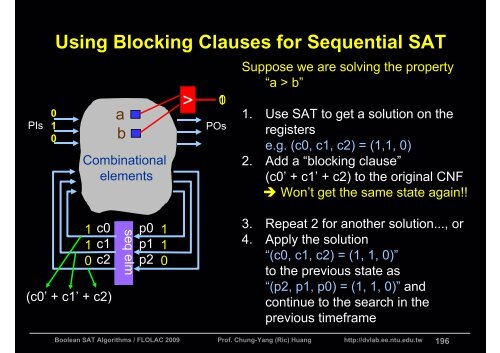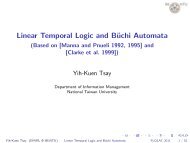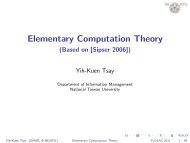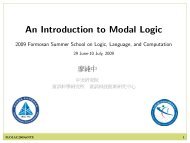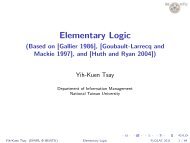- Page 1 and 2:
Boolean Satisfiability (SAT) Algori
- Page 3 and 4:
What is Verification What’s the p
- Page 5 and 6:
#Transistors in Intel’s CPUs Year
- Page 7 and 8:
What is Verification What’s the p
- Page 9 and 10:
And of course, don’t forget the i
- Page 11 and 12:
Improvement on Floating-Point Execu
- Page 13 and 14:
A 3-D plot of the ratio 4195835/314
- Page 15 and 16:
Aftermath... Intel hired 1000+ PhD
- Page 17 and 18:
How do you verify your design Bool
- Page 19 and 20:
Simulation-Based Verification Testb
- Page 21 and 22:
Like Finding a Bug in an Ocean… B
- Page 23 and 24:
Then why is simulation still the ma
- Page 25 and 26:
And of course, simulation approach
- Page 27 and 28:
Using hardware to speed up simulati
- Page 29 and 30:
Verification vs. Testing Objective
- Page 31 and 32:
Observability Problem --- Solved In
- Page 33 and 34:
The Fact More than 90% of properti
- Page 35 and 36:
ABV Example --- OVL module assert_n
- Page 37 and 38:
Any Problem Whose Problem “My big
- Page 39 and 40:
Think --- If you simulate your desi
- Page 41 and 42:
Simulation and Assertion-Based Veri
- Page 43 and 44:
Formal Verification Technologies De
- Page 45 and 46:
Proving “assert_always(p)” In
- Page 47 and 48:
Set of Reachable States t0 t1 t2 t3
- Page 49 and 50:
Combinational Invariance It is wor
- Page 51 and 52:
In this topic, we will use SAT engi
- Page 53 and 54:
Boolean Satisfiability (SAT) Fundam
- Page 55 and 56:
Complexity of SAT solver We have le
- Page 57 and 58:
Something like --- A Decision Tree
- Page 59 and 60:
Boolean Satisfiability Checking for
- Page 61 and 62:
A Typical Combinational SAT Algorit
- Page 63 and 64:
A Typical Combinational SAT Algorit
- Page 65 and 66:
a b c d combSat (g7, 0) 1 g1 g2 g3
- Page 67 and 68:
a b c d combSat (d, 1) 1 1 g1 g2 g3
- Page 69 and 70:
a b c d combSat (d, 1) 1 1 g1 g2 g3
- Page 71 and 72:
How many decisions did we make Ther
- Page 73 and 74:
Logic Implications Also called “
- Page 75 and 76:
How to schedule and evaluate these
- Page 77 and 78:
Trying to avoid fruitless implicati
- Page 79 and 80:
What’s the improvement Worse case
- Page 81 and 82:
Sounds good for all-1’s forward i
- Page 83 and 84:
2-Watched-Literal Algorithm H. Zhan
- Page 85 and 86:
2-Watched-Literal Algorithm Example
- Page 87 and 88:
Caching Effect: Reducing from O(n)
- Page 89 and 90:
Difference between circuit and CNF
- Page 91 and 92:
Any problem Remember there is only
- Page 93 and 94:
A Closer Look 0 1 1 0 0 0 11 1 11 1
- Page 95 and 96:
Direct Implication 1. Single source
- Page 97 and 98:
Direct vs. Indirect Implications 0
- Page 99 and 100:
Watch Scheme for XOR Gate n-input
- Page 101 and 102:
Applications of Logic Implication W
- Page 103 and 104:
Redundancy in a Combinational Circu
- Page 105 and 106:
Mandatory Assignment Example (1) Fa
- Page 107 and 108:
1. How do we know a wire in a combi
- Page 109 and 110:
How to add an extra wire to make th
- Page 111 and 112:
RAMBO: Redundancy Addition and remo
- Page 113 and 114:
Is (g5 g9) redundant c 0 b 0 g1 1
- Page 115 and 116:
Filtering Out Impossible Candidate
- Page 117 and 118:
How do we add “something” to a
- Page 119 and 120:
A Two-Way Redundancy Addition and R
- Page 121 and 122:
RAR Example (w t : g6 g7) c g4 0 0
- Page 123 and 124:
2-Way RAR Algorithm 1. Given a targ
- Page 125 and 126:
Creating a Redundant Gate (2) g s1
- Page 127 and 128:
A closer look at the previous examp
- Page 129 and 130:
Single Wire Replacement Theorem in
- Page 131 and 132:
A closer look... MA(w t ) a MA(g d
- Page 133 and 134:
SRAR-Wire vs. Original RAMBO (FYI)
- Page 135 and 136:
Single Gate Replacement in SatRAR *
- Page 137 and 138:
Alternative Sub-circuit by SatRAR M
- Page 139 and 140:
CNF-Based SAT Algorithm 1. Davis, P
- Page 141 and 142:
Davis Putnam Algorithm M .Davis, H.
- Page 143 and 144:
Basic DLL Procedure - DFS (a’ + b
- Page 145 and 146: Basic DLL Procedure - DFS (a’ + b
- Page 147 and 148: Basic DLL Procedure - DFS (a’ + b
- Page 149 and 150: Basic DLL Procedure - DFS (a’ + b
- Page 151 and 152: Potentially exponential complexity!
- Page 153 and 154: Conflict-Driven Learning (a’ + b
- Page 155 and 156: Non-Chronological Backtracking (a
- Page 157 and 158: Deduced Implication from Learned Cl
- Page 159 and 160: Deduced Implication from Learned Cl
- Page 161 and 162: A Closer Look at the Implication Gr
- Page 163 and 164: Conflict Analysis 2 a = 1 a = 1 a1
- Page 165 and 166: Which constraint is the best to add
- Page 167 and 168: Conflict-Driven Learning Decision l
- Page 169 and 170: A closer look at binary decision tr
- Page 171 and 172: Conflict-Driven Non-Chronological B
- Page 173 and 174: What we have learned on SAT... 1. E
- Page 175 and 176: Static Decision Ordering Decision
- Page 177 and 178: zChaff’s Variable State Independe
- Page 179 and 180: More decision heuristics... Variabl
- Page 181 and 182: Remember when we talked about confl
- Page 183 and 184: Various Learning Techniques Other
- Page 185 and 186: Learned by Signal Correlations A p
- Page 187 and 188: Conflict vs. Success-Driven Learnin
- Page 189 and 190: Success-Driven Learning Ref: Shuo,
- Page 191 and 192: What can we do to make the learning
- Page 193 and 194: Recalled, the SAT algorithms we hav
- Page 195: SAT-Based Verification We know tha
- Page 199 and 200: Bounded Model Checking (BMC) Algori
- Page 201 and 202: Application of BMC If the property
- Page 203 and 204: K-induction Induction: SSS2000 •
- Page 205 and 206: Induction SAT for (k = 0 to infinit
- Page 207 and 208: Does “Induction SAT” guarantee
- Page 209 and 210: Induction over simple paths Let sim
- Page 211 and 212: Is the recurrence diameter the same
- Page 213 and 214: Outline Overview of Hardware Verif
- Page 215 and 216: Symbolic model checking without BDD
- Page 217 and 218: Limitation of Formal Engine Still
- Page 219 and 220: Localization abstraction Property:
- Page 221 and 222: Image and over-approximated image
- Page 223 and 224: Remember: Resolution a ∨ b ∨ ¬
- Page 225 and 226: Generating refutations Refutation
- Page 227 and 228: Extraction of Unsatisfiability Core
- Page 229 and 230: Some Definitions for Unsatisfiabili
- Page 231 and 232: Interpolants from Proofs Deriving
- Page 233 and 234: SAT to compute set of reachable sta
- Page 235 and 236: Overapproximation An overapproxima
- Page 237 and 238: Adequate image Img(P,C) P Img’(P,
- Page 239 and 240: Huh A A' B P C C C C C C C F A ⇒
- Page 241 and 242: Reachability algorithm let k = 0 re
- Page 243 and 244: Interpolation-based MC Fully SAT-ba
- Page 245 and 246: Conclusion on Boolean SAT Algorithm
- Page 247 and 248:
Some popular SAT engines SATO •


